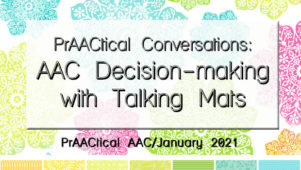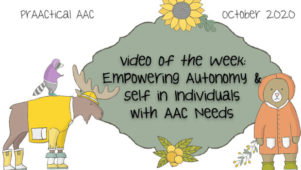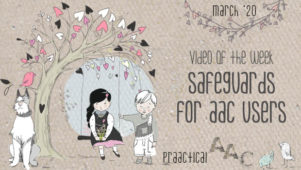Safety Matters: 5 Resources for People who Use AAC

Though she was not the first of my clients with cerebral palsy who made me think long and hard about safety, Marla was the one who kept me up at night. It was the seventies, and I was a PCA when institutionalization was on the way out and community living was gaining ground. Marla lived on her own in an apartment and, for awhile when I was a college student, I visited her in the morning to get her up and at night to put her to bed. During the day, she could get around reasonably well and call for help if she needed it. But at night, after she was settled in bed, she was pretty much stuck there until someone returned in the morning. She didn’t have the physical skills to use a phone while lying down, and, if there was AT that would have helped, I didn’t know about it.
–
And so, I lay awake, stomach acid churning, trying to wave away visions of electrical fires and burglars. When Marla had a chance to move across the continent to a place with better independent living supports, I was her most ardent supporter. At the time, I thought I was just helping her move onward and upward. But now, I realize that I was probably developing an ulcer from the stress and just couldn’t stand another season of sleepless nights. What made us think that leaving someone with significant physical challenges alone without a way to reach someone was acceptable? Marla knew the risks better than I, and she chose them over institutional living, which had its own dangers.
–/my-safety-responsibility-plan.jpg)
Now, thankfully, we don’t have to make that choice. With appropriate supports, people in community living arrangements don’t face the same level of risk as Marla did. Still, there are challenges to personal safety and that’s the reason for this post. Here in the US, June is National Safety Month, and in honor of that we share a number of safety-related resources of interest to people with AAC needs.
–
1. Safety for People Who Use AAC: With the leadership of Barbara Collier, this project from Augmentative Communication Community Partnerships-Canada (AACPC), has extensive safety resources on privacy, money and valuables, communicating in an emergency and other key topics. You can explore the information and downloadable resources here.
–
2. First Responders and the Community: The Autism Risk and Safety Management site has links to videos, articles, and other resources that focus on ASD but may be helpful to individuals with many types of developmental disabilities.
–
3. Abuse, Discrimination and Crime: People with communication difficulties are vulnerable to abuse on many levels. Information and resources to help prevent and report abuse is available through AACPC here and through their -extensive project, Speak Up, here. There is so much that we appreciate about these projects and the resources they are sharing through their sites. Speak Up has an extensive repository of communication displays related to safety and sexual health. We’ve collected a number of their communication displays that relate to safety issues on Pinterest boards here and here.
There is also a set of very helpful guidelines for families, counselors, caregivers, and the justice system here.
–
4. Emergency Preparedness: One legacy of Hurricane Katrina has been a heightened awareness of the need for better emergency preparedness for people with disabilities. In the years that followed, there have been a growing number of projects with valuable resources on this topic. The AAC-RERC is one example of an organization that prioritized this issue . You can see resources here that were developed in conjunction with USSAAC and News-2-You. In addition, Temple University’s Institute on Disabilities has some very prAACtical resources, particularly on vocabulary related to emergency preparedness and downloadable materials for communication. There is also an insightful article on emergency communication hosted on the AAC-RERC site.
–
5. Wandering: Frantic phone calls, whirring helicopters, sightings along the highway. There is no fear like the fear of having someone you care about go missing. We are grateful for the new technologies that help keep our AAC friends safe. The Friendship Circle Blog has a great article with resource links. We also love these kinds of temporary tattoos.
—
/safety.jpg)
At first glance, safety may not seem like the domain of an SLP, but it is an important part of our work. Whether it is in preparing AAC materials, teaching people to use them, promoting self-advocacy, supporting families, or educating the community: Safety matters.
—
If you’re not safe, nothing else is even worth talking about.
Filed under: PrAACtical Thinking
Tagged With: communication boards, resources, safety, self-advocacy
This post was written by Carole Zangari
/abuse_emotional.png)




